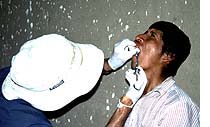
|
|||

Bolivia - Kota Mama V
Kota Mama V was the fifth in a series of six expeditions which began back in 1998. One of the key aims of the project was to prove, by navigating the river networks of South America, that the ancient peoples of the region used their waterways for trade and exploration.  Since 1998, the Scientific Exploration Society has
successfully navigated more than 7,500 km along rivers in Paraguay, Argentina, Bolivia and Brazil.
En route they have also surveyed and studied archaeological sites and aided local
communities. During these voyages many mysteries have been identified and whilst planning Kota Mama III in 2000, it was found that the Rio
Grande remained one of the last scientifically unexplored parts of South America.
Since 1998, the Scientific Exploration Society has
successfully navigated more than 7,500 km along rivers in Paraguay, Argentina, Bolivia and Brazil.
En route they have also surveyed and studied archaeological sites and aided local
communities. During these voyages many mysteries have been identified and whilst planning Kota Mama III in 2000, it was found that the Rio
Grande remained one of the last scientifically unexplored parts of South America.
Rising high in the Andes, not far from the legendary silver mountain of Potosi, the Rio Grande rushes eastward through the mountains cutting a series of gorges, some around 1500 metres deep, and runs south east for approximately 500 kilometres. Finally it bursts out onto the plains of the Chaco where a maze of channels and swamps, believed to have been created by an earthquake in the 1940s, halts the river's direct course. Until then it was possible to navigate from Santa Cruz to the cataracts of the Mamore and Madeira rivers before joining the mighty Amazon. Today the lower reaches of the Rio Grande are reasonably well known, but the gorges above the town of Abapo are relatively unexplored and this is the area on which the expedition focused. 
There is substantial evidence of ancient settlements along this part of the waterway and it is likely that it provided a trade route for the early people of the region. As the river slices through the Andean foothills it reveals fascinating and spectacular geological formations. The section of gorges between the source and Abapo is almost 400 kilometres. The top half of the route races through arid terrain more typical of the Altiplano, but lower down the river winds through dense tropical forest.  A wide range of wildlife is reported all along the route and it is probable that the Incas and their forebears settled along this
constant source of water. The few explorers who have descended into the gorge tell of enormous fossil beds containing the remains
of mastodont, giant sloth and glyptodont as well as evidence of early settlements.
A wide range of wildlife is reported all along the route and it is probable that the Incas and their forebears settled along this
constant source of water. The few explorers who have descended into the gorge tell of enormous fossil beds containing the remains
of mastodont, giant sloth and glyptodont as well as evidence of early settlements.
As far as could be ascertained no one has navigated the entire length of this formidable river. It was particularly challenging because the canyon beds are littered with gigantic boulders. When in flood this stretch of the Rio Grande becomes a raging torrent as the water thunders over the boulders. However with care it was possible to navigate the river at low water, although even then the inflatable boats had to be carried over or round some obstacles. With the fierce temperatures in some of the canyons this proved to be quite a task at times. The community aid program won many hearts and minds by providing medical and dental assistance, books and computers for schools, hospital equipment and spectacles.  The grateful people then helped us to make archaeological discoveries, greatly appreciated in Bolivia, which is
encouraging eco-tourism. Some incredibly well preserved cave paintings were found thanks to guidance from local villagers after dental
treatment. Ruins of the Inca empire and sacred sites, known only to a few, were surveyed and numerous cave burials seen, some containing
hundreds of skeletons.
The grateful people then helped us to make archaeological discoveries, greatly appreciated in Bolivia, which is
encouraging eco-tourism. Some incredibly well preserved cave paintings were found thanks to guidance from local villagers after dental
treatment. Ruins of the Inca empire and sacred sites, known only to a few, were surveyed and numerous cave burials seen, some containing
hundreds of skeletons.
Clearly the area had a much larger population in Inca times than today. A very significant find of a complete Inca pot was made and the handed over for display at the Vallegrande museum. Hopefully the development and protection of these sites will aid the economy of the area. Possibly the largest single community aid project of the expedition was to oversee the installation of a new water pipe for the town of Vallegrande. A significant town, with a population of 8500, which had water rationing imposed as the old pipe had corroded. However, with the aid of a $10,000 donation from the charity Just a Drop the new pipe was funded and installed. I filmed the expedition with assistance from Otto Brockway and Charlie Fraser. The filming has now been edited and is under consideration for broadcast.
Mike is an honorary member of the The Anglo-Bolivian Society. Click here to view the Bolivia photo gallery! |
|||
|
|
